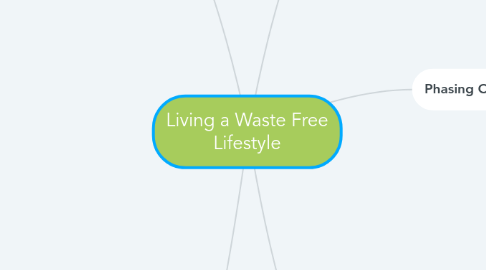
1. Using Sustainable Materials
1.1. Bamboo
1.1.1. Bamboo is a very versatile plant that can be used in a myriad of ways to replace plastic products. It can be grown in sustainable ways, as it in not a water intensive plant and it contributes to soil health.
1.1.1.1. Straws
1.1.1.2. Toothbrush
1.1.1.3. Clothing
1.1.1.4. Cutlery/Kitchen Utensils
1.2. Wood
1.2.1. Wood is a god alternative to plastic because it biodegrades at the end of its use and it can be created sustainably.
1.2.1.1. Cutlery/Kitchen Utensils
1.2.1.2. Furniture
1.2.1.3. Bowls and Plates
1.2.1.4. Hairbrush
1.3. Metal/Stainless Steel
1.3.1. Metal and stainless steel products generally have a much longer life than plastic ones meaning they have to be replaced less often. They also doesn't contain as many toxins as plastic materials, so they are safer for human use and the environment.
1.3.1.1. Straws
1.3.1.2. Kitchen Utensils
1.3.1.3. Water bottle/Travel mug
1.3.1.4. Razor
1.3.1.5. Food containers
1.4. Cotton
1.4.1. Cotton comes from a plant, meaning it is a renewable resources. Cotton can be used to replace plastic but it can also be an alternative for other synthetic materials in cloth.
1.4.1.1. Shopping Bags
1.4.1.2. Hair Ties
1.4.1.3. Beeswax Food Wrap
1.4.1.4. Sanitary Pads
1.4.1.5. Towels and Wipes
1.4.1.6. Clothes
1.5. Personal Care and Hygiene
1.5.1. Many household products and personal care products come in disposable plastic containers. There are methods and products that eliminate this waste and make cleaning sustainable.
1.5.1.1. Laundry Detergent Powder
1.5.1.2. Bar Shampoo and Conditioner
1.5.1.3. Dish Soap Bars
1.5.1.4. Dryer Balls
1.6. Glass
1.6.1. Glass is also used as an alternative for plastic because it lasts longer, is non-toxic and all glass can be recycled.
1.6.1.1. Candle holders
1.6.1.2. Water bottle/Travel mug
1.6.1.3. Food Containers
1.6.1.4. Containers for things like Deodorant, Sunscreen etc
1.6.1.5. Bowls and Plates
2. Environmental Values
2.1. This solution requires a shift to valuing the environment over convenience. Our society is centred around making things as easy as possible but that often comes at environmental cost, which cannot be ignored.
2.2. There needs to be realization that the resources on the earth are finite and the more we use, the less will be available for other people or for future use.
2.3. This solution also requires people to value their possessions. If there is a shift in mindset towards taking good care of your things and repairing rather than replacing, people will consume less products and therefore create less waste.
2.4. Many people make the argument that a zero waste lifestyle is more expensive because plastic items, such as bags, coffee cups and plastic cutlery are cheaper. This is untrue because many zero waste products are designed to last for much longer and will outlast plastic products. So although the upfront cost may be higher, if people were willing to make an investment, it would pay off and they would end up saving money.
2.5. Overall, a shift towards a lifestyle that is less dependant on plastic requires a concern and regard for future generations. Sustainability is meeting the needs of the present without compromising the needs of the future, which is something we should be considering more in our daily lives and actions for the wellbeing of our species and the earth.
3. What is the issue?
3.1. Societal values of convenience above all has led to the increase in single use items catered to the immediate needs of consumers
3.2. Plastic is used in many aspects of our lives today, which is a unsustainable, non-degradable material that is one of the main contributors to the build up of garbage in landfills and in the environment.
3.3. Every piece of plastic that has ever been produced is still on the earth today. If we continue to depend on this material, the environmental will suffer greatly because plastic takes thousands of years to decompose.
4. Phasing Out Plastic
4.1. Role of Consumers
4.1.1. Consumers must change their purchasing patterns to reduce the amount of plastic goods that they buy.
4.1.2. There must be a shift from single use goods made for disposal, such as plastic water bottle, grocery bags, food containers, straws, etc. to products and materials that are eco friendly and last longer
4.2. Role of Corporations
4.2.1. Corporations must remove opportunities for customers to consume plastic products by offering more sustainable options without plastic.
4.2.1.1. This is often profitable in the long term and occurs due to regulation, social pressure or desire for environmental economic sustainability.
4.3. Role of Government
4.3.1. Governments can push legislation to reduce the amount of plastic materials sold and how much is used in certain industries. This requires forethought and regulation.
4.3.1.1. Legislation, like plastic bans, can help governments reach climate change goals, which many have signed onto due to concern for the future of human wellbeing and pressure from other nations.
5. Environmental Benefits
5.1. Less plastic in landfills
5.1.1. Chemical leaching into earth is reduced
5.1.2. Less land being converted into space for landfills
5.2. Less plastic products being produced.
5.2.1. Less carbon emissions from the production process.
5.2.2. No further strain on the environment from build up of plastic materials that do not biodegrade.
5.3. Reduced plastic entering ecosystems
5.3.1. Animals often confuse plastic waste such as bags, straws and old plastic cutlery for food which can be detrimental to their health and the health of their offspring.
5.3.2. As weather forces break down plastic materials into tiny pieces called micro-plastics, the organisms at the bottom of the food chain are impacted, which has a domino effect on other organisms and can cause ecosystem collapse.
5.3.3. Habitat destruction due to plastic waste would lessen. Currently, this is a huge issue in the ocean, as currents cause floating garbage to accumulate into huge masses, called garbage patches.

